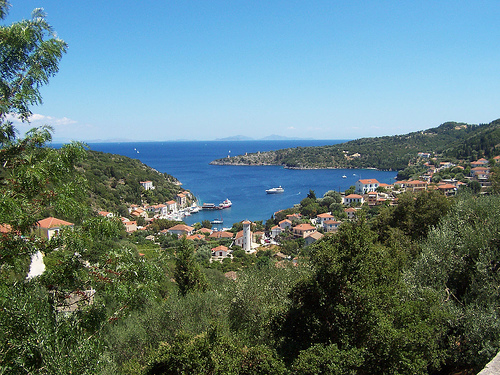

Location: Ionian Islands Map
"I dwell in shining Ithaca. There is a mountain there, high Neriton, covered in forests. Many islands lie around it, very close to each other, Doulichion, Same, and wooded Zacynthos-- but low-lying Ithaca is farthest out to sea, towards the sunset, and the others are apart, towards the dawn and sun. It is rough, but it raises good men." (Odyssey)
Ithaca Island is historic home of legendary Odysseus that is full of interesting places to explore. As you enter fjord like harbor you will see two French forts build here in 1805. Small island called Lazaretto was used by Venetians as a quarantine station since 1665 and from 1864 it was converted to prison. Now it is home to a church. Notable sights in this city include Archeological museum (Kallinikou, Ithaca town, tel (26740) 32200 closed mon) and Folklore museum ( Ithaca town, closed sun and mon). Cave of the Nymphs two miles from Ithaca is a place where Odysseus supposedly buried his wealth.
Ithaca island consists of the pre-existing
Municipality of Ithaca (Vathi) and seven Municipal Districts,
mountainous and coastal. Vathi, a picturesque town with a peculiar
bay that encloses the island of Lazaretto and its two Venetian
castles. During the peak summer months the population more than
doubles.
The island was named after Ithaca, the first
inhabitant of the island (son of Pterelaos and brother of Polyktor
and Niritos) or according to mythology he was the son of Poseidon
and Amfimeli. According to another hypothesis, the name comes from
the word Ithi (= cheerful) or from the word Ithis (= steep).
Vathi and the local districts of Anogi, Stavros and Kionio have been
characterized as Traditional Settlements, while the whole island has
been characterized as of special natural beauty.
Ithaca
presents a rich division on the east coast, characterized by many
bays and capes. The northernmost tip of the island is Cape Melissa,
while the southernmost is Cape Agios Andreas. Between these two ends
are inserted the bay of Frikon, the cape of Mavronas, the cape of
Agios Ilias, the bay of Molos, the cape of Schinos and other capes.
The length of the coasts reaches a total of 101 km. On the island
there are Mount Niritos (806 meters) and Merovigli (669 meters). It
has beaches of incredible beauty, such as Gidaki beach.
Characteristic of the island is its barren lands and water scarcity,
which hinder the development of agriculture. The island relies
financially mainly on tourism and seafaring. The name of the island
is known since antiquity, as it refers to the Odyssey. The general
assessment of the experts accepts the identification of today's with
Homeric Ithaca, explaining that the differences from the described
topography in the Odyssey arose either due to ignorance of the
topography of the island by the poet, or due to "poetic permission".